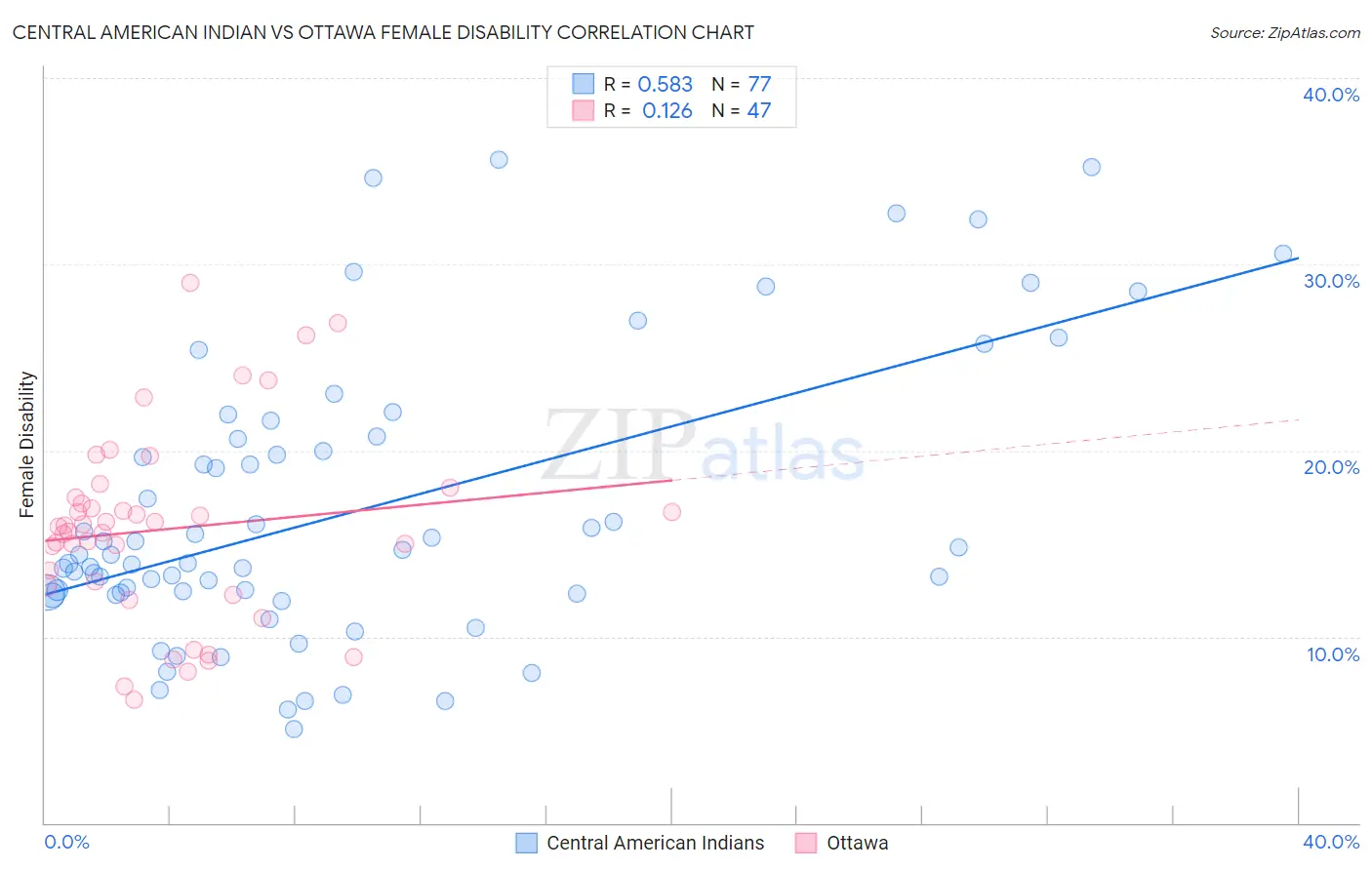Central American Indian vs Ottawa Female Disability
COMPARE
Central American Indian
Ottawa
Female Disability
Female Disability Comparison
Central American Indians
Ottawa
13.6%
FEMALE DISABILITY
0.0/ 100
METRIC RATING
307th/ 347
METRIC RANK
14.2%
FEMALE DISABILITY
0.0/ 100
METRIC RATING
327th/ 347
METRIC RANK
Central American Indian vs Ottawa Female Disability Correlation Chart
The statistical analysis conducted on geographies consisting of 326,112,462 people shows a substantial positive correlation between the proportion of Central American Indians and percentage of females with a disability in the United States with a correlation coefficient (R) of 0.583 and weighted average of 13.6%. Similarly, the statistical analysis conducted on geographies consisting of 49,954,639 people shows a poor positive correlation between the proportion of Ottawa and percentage of females with a disability in the United States with a correlation coefficient (R) of 0.126 and weighted average of 14.2%, a difference of 4.5%.

Female Disability Correlation Summary
| Measurement | Central American Indian | Ottawa |
| Minimum | 5.1% | 6.6% |
| Maximum | 35.6% | 29.0% |
| Range | 30.5% | 22.4% |
| Mean | 16.8% | 15.8% |
| Median | 14.4% | 15.9% |
| Interquartile 25% (IQ1) | 12.3% | 12.8% |
| Interquartile 75% (IQ3) | 20.7% | 17.5% |
| Interquartile Range (IQR) | 8.3% | 4.7% |
| Standard Deviation (Sample) | 7.6% | 5.1% |
| Standard Deviation (Population) | 7.5% | 5.0% |
Demographics Similar to Central American Indians and Ottawa by Female Disability
In terms of female disability, the demographic groups most similar to Central American Indians are Cree (13.7%, a difference of 0.46%), French American Indian (13.7%, a difference of 0.52%), Apache (13.7%, a difference of 0.63%), Hopi (13.7%, a difference of 0.92%), and Delaware (13.8%, a difference of 1.2%). Similarly, the demographic groups most similar to Ottawa are Comanche (14.2%, a difference of 0.44%), Navajo (14.2%, a difference of 0.55%), Native/Alaskan (14.1%, a difference of 0.69%), Black/African American (14.1%, a difference of 0.71%), and Pueblo (14.1%, a difference of 0.88%).
| Demographics | Rating | Rank | Female Disability |
| Central American Indians | 0.0 /100 | #307 | Tragic 13.6% |
| Cree | 0.0 /100 | #308 | Tragic 13.7% |
| French American Indians | 0.0 /100 | #309 | Tragic 13.7% |
| Apache | 0.0 /100 | #310 | Tragic 13.7% |
| Hopi | 0.0 /100 | #311 | Tragic 13.7% |
| Delaware | 0.0 /100 | #312 | Tragic 13.8% |
| Blackfeet | 0.0 /100 | #313 | Tragic 13.8% |
| Puget Sound Salish | 0.0 /100 | #314 | Tragic 13.8% |
| Alaskan Athabascans | 0.0 /100 | #315 | Tragic 13.9% |
| Spanish Americans | 0.0 /100 | #316 | Tragic 14.0% |
| Chippewa | 0.0 /100 | #317 | Tragic 14.0% |
| Paiute | 0.0 /100 | #318 | Tragic 14.0% |
| Iroquois | 0.0 /100 | #319 | Tragic 14.0% |
| Americans | 0.0 /100 | #320 | Tragic 14.1% |
| Potawatomi | 0.0 /100 | #321 | Tragic 14.1% |
| Pueblo | 0.0 /100 | #322 | Tragic 14.1% |
| Blacks/African Americans | 0.0 /100 | #323 | Tragic 14.1% |
| Natives/Alaskans | 0.0 /100 | #324 | Tragic 14.1% |
| Navajo | 0.0 /100 | #325 | Tragic 14.2% |
| Comanche | 0.0 /100 | #326 | Tragic 14.2% |
| Ottawa | 0.0 /100 | #327 | Tragic 14.2% |